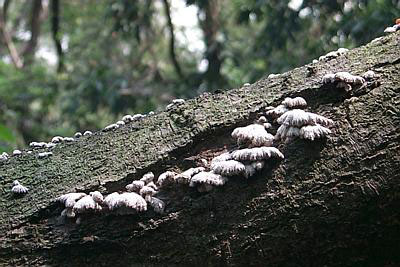

 |
 |
Diversity At A Glance
This
is a new column, geared towards people working in specific areas of
biodiversity, who may be ‘neophytes’ to other fields. It aims to introduce
interesting species of Hong Kong flora and fauna that might be encountered
during fieldwork. Distinctive physical characteristics and some interesting
ecological facts are included for each example. If you wish to contribute
to this column, or have any comments or suggestions, please contact
either
Jacqui
Weir (jesweir@hkusua.hku.hk)
or Sukh
Mantel (skmantel@hkusua.hku.hk).
| 'The last remaining abundant grouper in Hong Kong' | |
| 'Spilt-gill fungus Schizophyllum commune Fr.' | |
| 'Rousettus leschenaulti (Rousettus Fruit Bat / Leschenault's Rousette Bat)' |
'Split-gill fungus Schizophyllum commune Fr.'
by Alvin Tang
This fungus is commonly found from March to October in forests and shrubland associated with dried or dead trunks of Lithocarpus spp. or Acacia spp. In Hong Kong it is common in Tai Mo Shan, Tai Po Kau and Sai Kung. It is probably the most widespread fungus in the world, being found everywhere except Antarctica, where there is no wood substrate. The gills produce spores on their surface. They appear to be split because they can dry out and re-hydrate many times over the course of a growing season. This makes the fungus easily recognisable, as each gill is divided longitudinally into two or more parts. The fruiting body is fan-shaped, leathery, and 2-4 cm in diameter (Fig. 2). The upper surface has dense hair, and is light greyish-brown when moist, but ashy grey to white when dry. The stalk is usually absent and the spore print (print of spores on paper) is white.
This fungus is well adapted for a climate with sporadic rains, and the fruiting bodies can function for several years. It is a very successful wood decaying fungus that causes white rot. Although not poisonous, it is too small and tough to eat! It has been used as traditional medicine in Yunnan to cure gynaecological illnesses.
 |
| Fig. 2. Schizophyllum commune Fr. on dead wood on Tai Mo Shan. |
'Rousettus leschenaulti (Rousettus Fruit Bat/ Leschenault’s Rousette Bat)'
Rousettus leschenaulti is one of two species of fruit bats in Hong Kong, the other being Cynopterus sphinx. Rousettus is the largest of Hong Kong’s bats, and is quite easy to identify by its size, having a body length of up to 14 cm and a wingspan of around 40 cm. Despite being the largest bat in Hong Kong, its resident status here was overlooked until 1989, when it was rediscovered by Dr. Gary Ades (Kadoorie Farm and Botanic Garden). Prior to this the species had been regarded as a vagrant, with the only known specimen dating back to the 1800s.
Bat identification is made easier by the use of bat detectors. These convert the ultrasound emitted by bats into sound that is audible to humans. Old World fruit bats (Megachiroptera) are generally distinguished from other bats (Microchiroptera) by the absence of ultrasound calls. While the Microchiroptera use echolocation for navigation tasks such as locating insect prey in flight or detecting ripples on water surfaces, Megachiroptera rarely use ultrasound. The extent to which Rousettus leschenaulti does so is still unclear. However some ultrasound is produced by clicking the tongue. This is in contrast with other bats, which produce it in the larynx.
Rousettus leschenaulti in Hong Kong often roost in man-made structures such as abandoned mines or water tunnels, but are also known to roost in sea caves. A very large roost near Shek Kong in the New Territories used to contain thousands of these bats, but numbers there have recently been dramatically reduced. The reason for this is not clear.
|
|
P.15 |
|
Porcupine! |
 Copyright © 2000 |